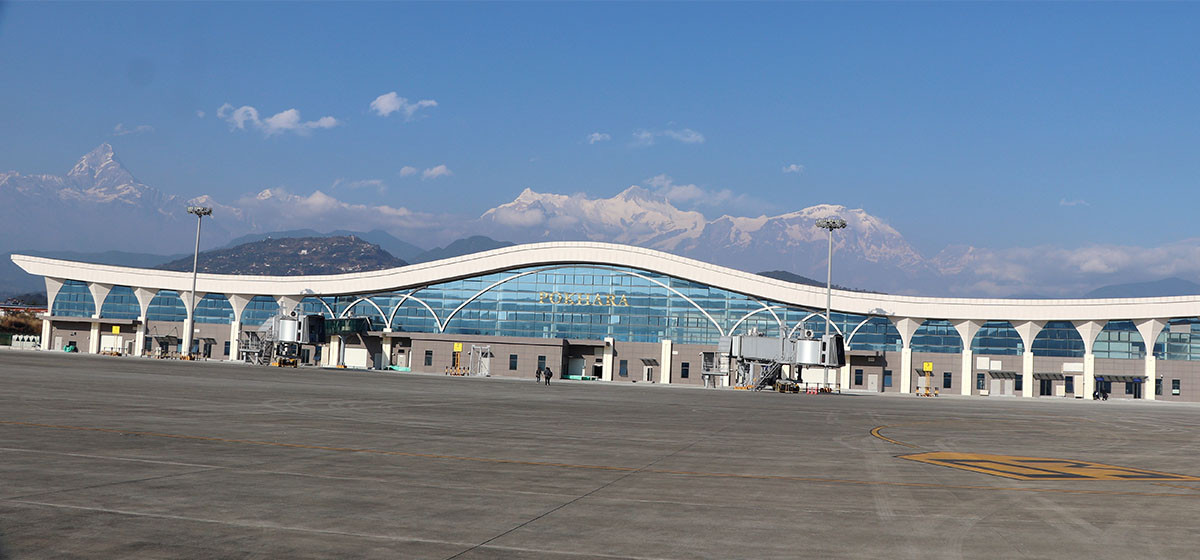MUSTANG, April 7: With the Beni-Jomsom-Korala road construction project making significant progress, the number of flights between Pokhara and Jomsom has dropped by two-thirds. Jomsom Airport, once bustling with passengers during peak tourist seasons, now sees fewer travelers. Previously, small twin-engine planes operated early morning flights from Pokhara to Jomsom, but nowadays, the airport is quiet with only a few passengers in the mornings.
Before the national highway construction began, more than 300 tourists flew daily from Pokhara to Mustang. Now, that number has been reduced by half. The upgraded Korala road, with over two-thirds of the dirt road between Beni in Myagdi and Muktinath in Mustang now paved, is the main reason for this decline.
With the road paved, air travel has decreased this season compared to previous years, said Keshav Lamsal, head of the Jomsom Civil Aviation Office. "Before the Korala road upgrade, we had up to 18 flights daily," he said. "Now, many tourists prefer traveling by road to Mustang."
With the end of winter and the arrival of spring, this is an ideal time to visit Mustang. However, Sujan Lalchan, Jomsom manager of Tara Airlines, explained that the decrease in flights is caused by the tourists’ preference of travel by road to air travel.
Both int’l and domestic airlines start exploring alternatives a...

"Earlier, we struggled to provide tickets for passengers. Tourists bought two-way tickets for the Pokhara-Jomsom route, but now, with fewer bookings, we often have to send empty flights," Lalchan said. "This issue has worsened over the years, leading to a gradual reduction in flights."
Indian tourists typically buy round-trip tickets to visit Muktinath and return the next day, while most international tourists buy one-way tickets, leaving Jomsom flights nearly empty.
"Earlier, locals and staff filled the flights, but now, with the road being better, most tourists prefer to travel to Pokhara by road,” said Suman Thakali, Jomsom manager for Summit Airlines.
Another factor contributing to the reduction in flights is the safety concerns surrounding air travel. The route has experienced several aviation accidents. To reduce aviation risks, the Civil Aviation Authority of Nepal (CAAN) has implemented new regulations and increased monitoring, which has led to fewer flights.
Although travel agencies continue to book tickets for Pokhara-Jomsom flights, canceled flights result in passengers being sent to Mustang by road. Traveling by road not only saves on flight costs but is also more convenient, as transport is readily available.
As a result, more tourists are opting for road travel due to its convenience and lower costs. Local residents, workers, security personnel, and others also rely on the road for their daily commutes.
Currently, only 5 to 6 flights operate daily between Pokhara and Jomsom, with 80% percent of passengers being Indian and 20% from other countries, according to the Jomsom Civil Aviation Office. Before the national pride Beni-Jomsom road project, the number of flights reached up to 18 per day during favorable weather.
Previously, only Indian and international tourists could get tickets, while Nepali tourists faced difficulty securing seats. Additionally, due to the price disparity, Nepali locals and tourists endured challenges, as tickets for foreigners were significantly more expensive. In some cases, flight tickets were only available in emergencies, such as for medical reasons.
Now, however, improved road conditions and lower travel costs have led to fewer tourists relying on flights.









-1200x560_20230115125633.jpg)



























